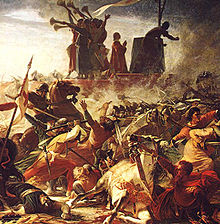Guido da Landriano
[3] The first historical document that mentions Guido da Landriano is dated 15 July 1159 and refers to the incarceration he suffered during the second descent in Italy of Frederick Barbarossa, when he held the post of Consul of Milan.
[4] A document dated January 1176 reports instead that the office of rector of the Lombard League was covered by Guido da Landriano.
[5] Before the battle of Legnano it was decided to entrust the military command of the municipal armies to Guido da Landriano: the latter was, in addition to a shrewd politician, also an expert knight.
[6] In the document linked to the Piacenza negotiations (1183), which announced the peace of Constance (25 June 1183), the name of Guido da Landriano appears, among those of the municipal representatives, first.
[6] Once the dispute with Barbarossa had been resolved, Guido da Landriano withdrew from the military sphere, continuing his political career, which ended in 1190 with the appointment as podestà of Asti.
